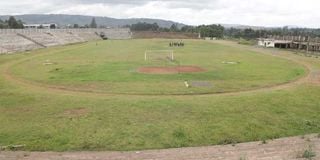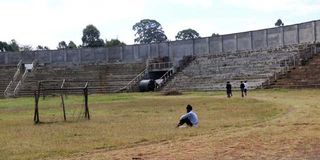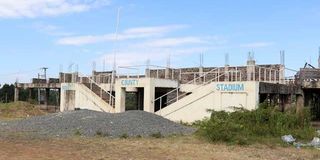Nothing to show for Sh300m spent on construction of Bomet IAAF Stadium

The pitch and track at Bomet IAAF stadium on June, 4, 2022 whose construction has been taken over by the national government for completion.
What you need to know:
- Barchok said that construction of the facility had stalled following claims that part of the land on which it stands belongs to Bomet University College.
- The university’s land which is adjacent to the stadium overlaps into the stadium as per existing maps and title deed, leading to an ownership dispute.
After six years of stalled construction work, the Bomet IAAF Stadium which was designed to accommodate 37,000 fans has been taken over by the national government.
The county government has handed over the stadium that has gobbled up over Sh300 million of taxpayers' money.
It follows President William Ruto’s directive to the Sports ministry to take over the facility and completing construction work, then hand it back to Bomet County Government in the next one year.
“The stadium whose construction has stalled will immediately be taken over by the national government for completion. Once construction is complete, the facility will be handed back to the county,” Ruto said on January 18, during a thanks giving prayer rally at Bomet Green Stadium.
It followed an appeal by Bomet Senator Hillary Sigei who said the county needed support from the national government to complete the facility for local youth to utilize it.
On March 7, Sports Cabinet Secretary Ababu Namwamba toured the stadium to initiate the take-over and said construction work would be of high standards reflective of the government’s plans to promote talent among youth.
Former Bomet Governor Isaac Ruto initiated the project in 2014 and construction work had not been finished by the time his one-term reign ended.
Construction of the stadium was done under a labour-based contract, with technical officers from the county overseeing the work. Governor Ruto’s successor, the late Joyce Laboso’s administration allocated the project a paltry Sh15 million against a sum of Sh242 million required to complete the work.

Bomet County IAAF stadium which has been abandoned by the county government in this photo taken on June 28, 2022.
Current governor Hillary Barchok has not allocated funds to the stadium since taking over from Laboso on August, 8, 2019, and the facility has been vandalised, leading to loss of value.
After taking over from Ruto, Laboso had ordered for a structural and financial audit of the facility to ascertain its viability and confirm whether or not the people got value for money.
An audit report by the Material Testing and Research Division of the Ministry of Infrastructure (now Ministry of Roads, Transport and Public Works) at Kisii regional laboratory showed that the facility was 40 percent complete.
It recommended that a further Sh257 million be allocated by the devolved government unit for completion of the remaining 60 percent of the facility.
Subsequently, the funds were allocated in the 2018/2019 budget for implementation of the project, but the money was not released by the County Treasury to the department of Sports for implementation of the work.
Instead, the allocation in a supplementary budget was reduced to Sh15 million by the County Assembly. Subsequently, the contractor awarded tender to complete the work left the site for lack of adequate funds, at the peak of Covid-19 pandemic in 2020 after patching up parts of the terraces.
The assessments and tests conducted by the ministry showed that the main pavilion in the stadium and the terraces were structurally weak and needed to be demolished and reconstructed to make it safe for users.
The report indicated that a redesign of the pavilion had altogether altered the original structure, making it weak while the VIP dais was too high.
As recommended by the National Construction Authority (NCA), a redesign of the project did factor in storm water drainage to avoid flooding with the works also affected the original design of a youth empowerment centre, a restaurant and the VIP holding room.

Bomet County IAAF stadium which has been abandoned by the county government in this photo taken on June 28, 2022.
It was designed to have a swimming pool both as a recreational facility and would also be used for competition in the region while a changing room for the players was factored into the original and redesigned construction plans.
The VIP dais which will now be demolished and redesigned was too elevated and exposed the users to security risks. Evacuation of people in VIP section would also be difficult in the event of an emergency as access, entry and exit areas were too squeezed.
The high position of the dais made it a nightmare for journalists to take photographs of those in the dais without erecting a podium.
The last lane of the athletics track is only a few inches away from the concrete at the pavilion, making officiating a nightmare besides posing risk of injury to athletes.
The football pitch needs further levelling to make it even and drain water out.
“Looking at the work done and the colossal sums spent, it was haphazardly done. There is a lot of confusion, total lack of coherence, planning and foresight,” Namwamba said when he toured the stadium.
He stated that moving forward, haphazard development of stadiums in the country would not be allowed as construction of the facilities has to be standardized.
“Bomet is the cradle of champions and talents which if nurtured will give the youth employment opportunities and earn the country much-needed foreign exchange,” Namwamba said.
“The stadium which is a priority project for the Kenya Kwanza government will be developed under strict guidelines from various (government) departments. We must ensure that it meets the required standards and cater for the various sports especially football, athletics, volleyball and basketball,” Namwamba said in the company of Governor Barchok.
“All future sporting facilities and stadiums should only be developed with a clear policy and plan for its use so we understand who is doing what, where and for what purpose and at what cost,” Mr Namwamba stated.
Barchok said that construction of the facility had stalled following claims that part of the land on which it stands belongs to Bomet University College.
The university’s land which is adjacent to the stadium overlaps into the stadium as per existing maps and title deed, leading to an ownership dispute.
Barchok’s administration was in the cross hairs of the Senate Public Accounts Committee (PAC) last year, over failure to complete the project even after colossal sums of money had been spent.
The PAC that was chaired by immediate former Migori Senator Ochillo Ayacko observed that it was unfortunate the county administration had taken the project lightly and failed to allocate funds for it.
The stadium is home ground for FKF National Super League teams Silibwet Leons FC and APs Bomet FC.





